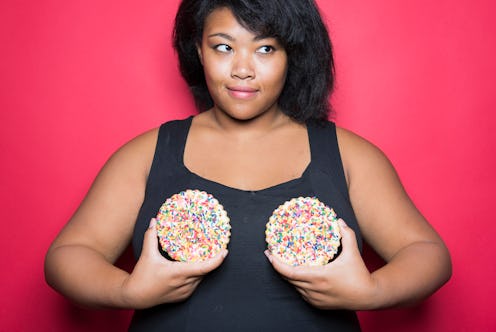
It's safe to say that our culture is obsessed with breasts — but how much do we actually know about them, other than the fact that we're attracted to their outward appearance? AsapSCIENCE has created a quick guide to understanding how the science of boobs works in less than four minutes, giving you an easy path towards understanding your boobs academically. I never cease to be saddened by how little we actually know about our bodies, despite all of the attention around them; as the narrator Rachel Salt says, "There is so much about breasts that isn't discussed or is deemed taboo," which is all too true, even though it shouldn't be. Boobs are pretty great, so it's worth actually knowing what they are and how they work, right?
Let's not forget that it's not just humans who have breasts; they're characteristic of all mammals. Since mammals give birth to live young, their bodies are able to respond to the miracle of birth by causing their breasts to secrete milk (unlike non-mammicular animals like snakes or birds, which must forage for food for their babies). The term "mammal" is actually derived from "mammary," which refers to the mammary glands that are responsible for producing breast milk. Aren't our bodies so amazing?
For even more amazing science about breasts, let's examine three common breast matters from a scientific perspective. To see even more, watch the full video below.
1. Breast Size
What size your boobs are is often a contested topic, but there is a lot of science behind what determines our breast size. People often assume that how much you weigh factors into how large your boobs are, but while there is a positive correlation between weight and breast size, our genes also play a major role in this determination. Our breasts are also typically different sizes, so don't feel insecure if one of your boobs is bigger than the other — breast asymmetry is completely normal, although scientists don't yet fully understand why this happens. Fun fact: Your breast size also changes throughout your menstrual cycle!
2. Breastfeeding
Now, let's talk a little about how the anatomical purpose of breasts: To provide food for babies. You might already know that the ring of skin around your nipple is your areola, but did you know that those little bumps on your breasts are called Montgomery's Glands? They actually serve a purpose: By releasing a tasty oily secretion during the process, they help to keep your nipple lubricated and your baby satisfied during breastfeeding. Your nipples also do some pretty cool things during breastfeeding, such as sending a message to your brain to release oxytocin, the cuddle hormone, and to create more prolactin, an essential hormone to milk production. This response can be triggered by just hearing a baby cry, even if it isn't yours.
3. Sexual Pleasure
Your breasts can bring you some incredible sexual pleasure! Yes, I mean to you, not only your partner. The video cites a study that found stimulating nipples can increase arousal in 82 percent of women. It's not just for the ladies, either, as the same study found that 52 percent of men can also get sexual pleasure from nipple stimulation. The same areas of the brain are activated when women's nipples are touched as when the clitoris or vagina are touched, which could explain why nipple play is so pleasurable.
To learn why breasts are often in danger and what kind of breasts people find to be the most aesthetically pleasing, watch the full video below.
Images: Andrew Zaeh for Bustle; AsapSCIENCE/YouTube (3)